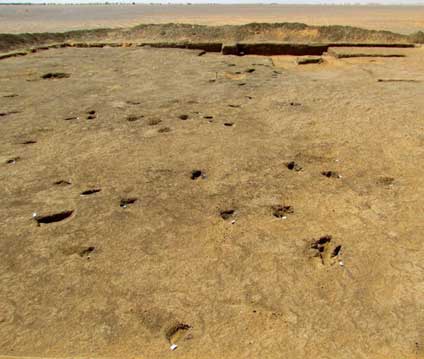
Discovery of 70,000-year-old African Settlement Challenges Previous Theories
Archaeologists from the Institute of Archaeology and Ethnology in Poznań have unearthed a very ancient village, which dates back an incredible 70,000 years, according to a news announcement in PAP. The settlement is the oldest known early Homo sapiens site with sizeable permanent structures in Africa and points to a much more advanced level of human development and adaption in Africa in the Middle Palaeolithic than previously realised. It also contradicts previously held beliefs that construction of permanent structures did not occur until the so-called Great Exodus from Africa and settling in the colder parts of Europe and Asia.

Remnants of the Palaeolithic settlements in Affad. Project director Dr. Marta Osypińska
The discovery was made at an archaeological site in the Affad District of Southern Dongola in northern Sudan. The site, known as Affad 23, consists of traces of light wooden structures, remnants of a village and utility areas, such as a large flint workshop, and an area for butchering animals for meat, which was placed away from the centre of the village. The fossilised remains of animals at the site demonstrates that the ancient inhabitants of the village hunted large game, such as hippos, elephants, and buffalo, medium-sized species, such as gazelle and antelope, and small monkeys and rats. The ancient artifacts and fossils had been preserved in the alluvial deposits formed by an ancient channel of the Nile in the Affad region.

Map showing location of archaeological site Affad 23 in Sudan. Image source: Wikipedia
The combined data concerning the position of the site, composition of the lithic assemblage, freshness, refittings and dispersion of the artifacts point to a late Middle Palaeolithic site, approximately 70,000 years old, however, the researchers now need to carry out detailed testing, including optically stimulated luminescence to precisely date the time period in which the Paleolithic hunters lived there.
“At this stage we know that the Middle Palaeolithic settlement episode in Affad occurred at the end of the wet period, as indicated by environmental data, including the list of hunted animal species. But in the distant past of the land such ecological conditions occurred at least twice” about 75 millennia and about 25 millennia ago. Determining the time when people inhabited the river bank near today’s Affad is the most important objective of our project,” said prehistory expert Piotr Osypiński.
Szymon Zdziebłowski, from PAP - Science and Scholarship in Poland, writes that the data obtained in the excavation “not only greatly enrich the knowledge about life in the time of the conquest of the Old World by the modern man. They also allow to determine the degree of intellectual development, indicating specific, rational behaviour, and the ability of planning.”
Featured image: Excavating the Palaeolithic level. Credit: Project director Dr. Marta Osypińska.
















Comments
i always appreciate a map included in an article! i'm geographically challenged.
love, light and blessings
AB